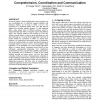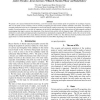182 search results - page 31 / 37 » Activity recognition using temporal evidence theory |
MM
2006
ACM
14 years 1 months ago
2006
ACM
We present an efficient system for video search that maximizes the use of human bandwidth, while at the same time exploiting the machine’s ability to learn in real-time from use...
CVPR
2006
IEEE
14 years 9 months ago
2006
IEEE
A system that could automatically analyze the facial actions in real time have applications in a number of different fields. However, developing such a system is always a challeng...
BC
2007
13 years 7 months ago
2007
We consider the issue of how to read out the information from nonstationary spike train ensembles. Based on the theory of censored data in statistics, we propose a ‘censored’ m...
GROUP
2003
ACM
14 years 21 days ago
2003
ACM
In order to support co-located collaboration, many researchers are now investigating how to effectively augment tabletops with electronic displays. As far back as 1988, orientatio...
LREC
2010
13 years 9 months ago
2010
We present LIPS (Lexical Isolation Point Software), a tool for accurate lexical isolation point (IP) prediction in recordings of speech. The IP is the point in time in which a wor...



